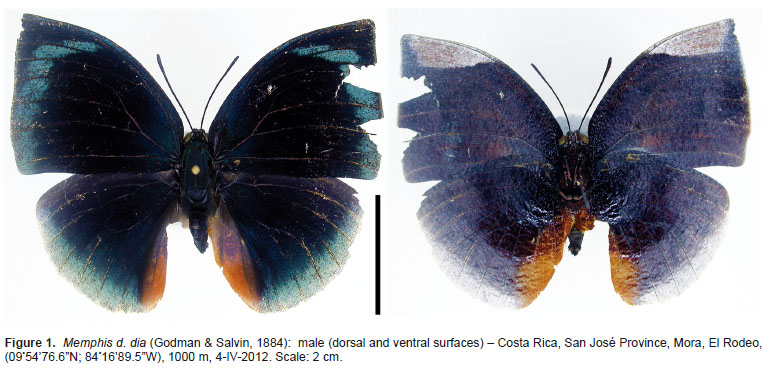Servicios Personalizados
Revista
Articulo
Indicadores
-
 Citado por SciELO
Citado por SciELO
Links relacionados
-
 Similares en
SciELO
Similares en
SciELO  uBio
uBio
Compartir
Revista Peruana de Biología
versión On-line ISSN 1727-9933
Rev. peru biol. vol.19 no.3 Lima dic. 2012
NOTA CIENTÍFICA
The first record of the butterfly Memphis d. dia (Lepidoptera: Nymphalidae, Charaxinae) in Costa Rica
Primer registro de la mariposa Memphis d. dia (Lepidoptera: Nymphalidae, Charaxinae) en Costa Rica
Jim Córdoba-Alfaro 1 and Luis Ricardo Murillo-Hiller 2
1 Bachillerato en Biología, Universidad Nacional de Costa Rica.
2 Zoocriadero de Mariposas, Escuela de Biología, Universidad de Costa Rica, 11501-2060, San José, Costa Rica.
Resumen
Se registra la presencia de Memphis dia (Godman & Salvin, 1884) (Lepidoptera: Nymphalidae, Charaxinae) en Costa Rica por un espécimen recolectado en la Zona Protectora El Rodeo (09°54’ 76,6”N; 84°16’ 89,5”W) el 4 de abril del 2012.
Palabras clave: Nuevo registro; Costa Rica; biodiversidad.
Abstract
The presence of Memphis dia in Costa Rica (Godman & Salvin, 1884) (Lepidoptera: Nymphalidae, Charaxinae) is reported herein, based on a specimen collected El Rodeo (09°54’ 76.6”N; 84°16’ 89.5”W) on April 4, 2012.
Keyword: New record; Costa Rica; biodiversity.
The butterfly genus Memphis (Hübner 1819) is from Mexico throughout the Neotropics including the islands of Trinidad and Tobago (DeVries 1987). According to Lamas (2004) it includes 62 species and 112 subspecies. Recently, Memphis marylena Choimet, 2009 was described in Costa Rica and Memphis aureola pueblaensis Dottax & Salazar, 2009 in Mexico. In Costa Rica, 23 species occur from sea level up to 1700 m on both continental slopes (DeVries 1987).
A male individual of Memphis dia (Fig. 1) was collected manually by the first author on April 4, 2012 at Finca El Rodeo, 1000 m elevation, Mora, San José (09°54’76.6”N, 84°16’ 89.5”W). The collecting site is an open area adjacent to a secondary growth forest in a protected zone approximately 20 km W of San José City. The specimen is deposited in the Córdoba-Alfaro collection (CPCA).
Memphis dia was not cited in any Costa Rican major butterfly lists such, as DeVries (1987). No records of this species are in the most important collections in the country, such as the National Museum of Costa Rica (MNCR) and the National Institute of Biodiversity (INBio). However, the presence of Memphis dia in Costa Rica was expected since Godman & Salvin (1884) described it from Panamá and later De la Maza (1987) reported it from Mexico.
El Rodeo presents some characteristics of Costa Rican Northwestern dry forest but in the undisturbed areas the butterfly community specific composition resembles more the wet forest habitats. A previous butterfly list for El Rodeo reported a total of 336 species (Vega & Gloor 2001) where Nymphalidae was the most diverse family, with 166 species, including seven of Memphis. It is remarkable to find a new Memphis species in an area where extensive collecting efforts have been done (Vega & Gloor 2001, Murillo-Hiller & Nishida 2004, Choimet 2009). Information concerning new records of this species are important to understand whether this species belongs to this community or if the record represents a migrant individual coming from a drier habitat as happens with many other Memphis species (DeVries 1987). More records like this will help us learn how many species are actually resident in this habitat and how they fluctuate throughout the year.
Acknowledgments
Thanks to Rusty Scalf by contribute with donation of binocular for this investigation. Thanks to Hugo Aguilar for providing work facilities at the Museo de Insectos of the Universidad de Costa Rica. To Germán Vega and Cecilia Pineda for allowing access to the collections at the Museo Nacional de Costa Rica. Finally to Julián Monge Nájera and Adrea Gonzalez Karlsson for correcting an earlier draft of the manuscript.
Literature cited
Choimet, X. 2009. Nouveaux Charaxinae néotropicaux (Lepidoptera: Nymphalidae). Revue des Lépidoptéristes de france. 18: 126-129
[ Links ]De la Maza, R. 1987. Mariposas Mexicanas. Guía para su colecta y determinación. Fondo de Cultura Económica. México, D. F. 304 pp. [ Links ]
De Vries, P. J. 1987. The butterflies of Costa Rica and Their Natural History: Papilionidae, Pieridae, Nymphalidae. Princeton University Press Princeton. 327pp. [ Links ]
Godman, F.D. & O. Salvin. 1879-1886. Biologia Centrali-Americana. Insecta. Lepidoptera- Rhopalocera. Dulau & Co., London. Vol. 1. 487 pp., 47 pls. [ Links ]
Lamas, G. 2004. Nymphalidae. Charaxinae, pp. 224-234. In: Lamas, G. (Ed.), Checklist: Part 4A. Hesperioidea-Papilionoidea. In: Heppner, J.B. (Ed.) Atlas of Neotropical Lepidoptera. Volume 5A. Association for Tropical Lepidoptera/Scientific Publishers, Gainesville, 428 pp. [ Links ]
Murillo-Hiller, R. & Nishida, K. 2004. Life history of Manataria maculata (Lepidoptera: Satyrinae) from Costa Rica. Revista de Biología Tropical 51 (2): 463-470. [ Links ]
Vega, G & P. Gloor. 2001. Lista preliminar de las mariposas diurnas (Hesperioidea: Papilionoidea) de la Zona Protectora El Rodeo, Ciudad Colón, Costa Rica. Brenesia 55-56: 101-122. [ Links ]














